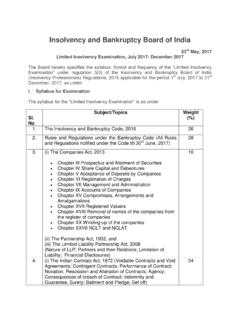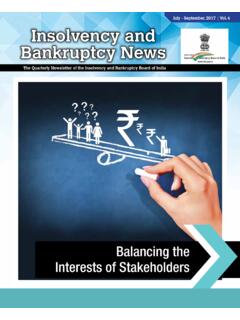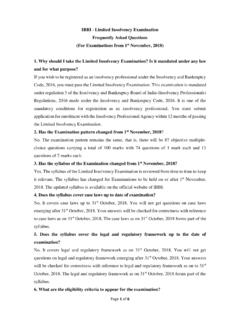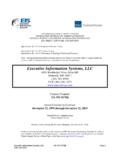Transcription of THIS PAGE HAS BEEN INTENTIONALLY LEFT BLANK
1 1 THIS PAGE HAS BEEN INTENTIONALLY LEFT BLANK 2 REPORT OF THE INSOLVENCY LAW COMMITTEE New Delhi, the 26 March, 2018 To, Honourable Union Minister of Finance and Corporate Affairs Sir, We have the privilege and honour to present this report of the Insolvency Law Committee, set up on 16th November, 2017, to make recommendations to the Government on issues arising from the implementation of the Insolvency and Bankruptcy Code,2016, as well as on the recommendations received from various stakeholders. 2. The Committee had the benefit of participation by various institutes, industry chambers and experts in various disciplines. It has tried to take a holistic and comprehensive view while suggesting changes in the Code and subordinate legislation keeping in mind the difficulties and challenges expressed by various stakeholders.
2 It has endeavoured to reconcile their competing interests, being mindful of the need for facilitating ease of resolving insolvency in India, and maximising value of assets locked up in non-performing assets. 3. We thank you for providing us an opportunity to present our views on the issues arising from implementation of the Insolvency and Bankruptcy Code, 2016 and related matters. Yours sincerely, (Shri Injeti Srinivas) Chairman (Dr. M. S. Sahoo) (Ms. Vandita Kaul) (Shri T. K. Vishwanathan) Member Member Rep. Member (Shri Sudarshan Sen) (Shri Shardul Shroff) (Shri Rashesh Shah) Member Member Member (Shri B.)
3 Sriram) (Shri Bahram Vakil) (Shri Sidharth Birla) Member Member Member (Dr. Makarand Lele) (Shri Sanjay Gupta) (CA Naveen ND Gupta) Member Member Member Shri Gyaneshwar Kumar Singh, Member Secretary 3 THIS PAGE HAS BEEN INTENTIONALLY LEFT BLANK 4 PREFACE The World bank Doing Business' Index 2018 recognized the sustained efforts and commitment of the Government of India as this year India became one of the top 10 improvers in the rankings released by the World bank . However, improving on the Doing Business rankings is not an easy task, especially for an economy that is as large and complex as India s.
4 Drafting a new piece of legislation is only the start. The more significant challenge is ensuring that the law is implemented in its true spirit. This can be achieved by periodically evaluating the law, especially when it is in its initial stages and practical challenges in implementation emerge. Towards this end, the Insolvency Law Committee was constituted by the Ministry of Corporate Affairs to conduct a detailed review of the Insolvency and Bankruptcy Code, 2016 in consultation with key stakeholders. This Report by the Insolvency Law Committee is a sincere attempt to encourage sustainable growth of the credit market in India, while safeguarding interests of various stakeholders. The key recommendations in this Report are as follows: (i) in recognition of the importance of Micro, Small and Medium Enterprises (MSMEs) to the Indian economy and the unique challenges faced by them, it has been recommended to allow the Central Government to exempt MSMEs from application of certain provisions of the Code.
5 Illustratively, since usually only promoters of an MSME are likely to be interested in acquiring it, applicability of section 29A has been restricted only to disqualify wilful defaulters from bidding for MSMEs; (ii) in order to address the problem of unintended exclusions under section 29A that disqualifies certain persons from submitting resolution plans under the Code, it has been recommended to streamline it so that only those who contributed to defaults of the company or are otherwise undesirable are rendered ineligible. Moreover, being mindful of the Non-Performing Assets (NPA) crisis in the country, the need to encourage the market for NPAs was felt and accordingly several carve-outs from section 29A have been recommended for pure play financial entities.
6 In order to prevent retrospective application of any proposed change, it has been recommended to add a proviso that the amendments shall be applicable to resolution applicants that have not submitted resolution plans as on date of coming into force of the said amendment; (iii) it has been recommended that home buyers should be treated as financial creditors owing to the unique nature of financing in real estate projects and the treatment of home buyers by the Hon'ble Supreme Court in ongoing cases. 5 Notably, classification as financial creditors would enable home buyers to participate equitably in the insolvency resolution process under the Code; (iv) to clear the confusion regarding treatment of assets of guarantors of the corporate debtor vis- -vis the moratorium on the assets of the corporate debtor, it has been recommended to clarify by way of an explanation that all assets of such guarantors to the corporate debtor shall be outside scope of moratorium imposed under the Code; (v) in order to fulfil the stated objective of the Code to promote resolution, it has been recommended to re-calibrate voting threshold for various decisions of the committee of creditors.
7 (vi) in order to enable the corporate debtor to continue as a going concern while undergoing Corporate Insolvency Resolution Process (CIRP) it has been recommended to empower the NCLT on the application of IRP/RP to allow expansion of the scope of essential goods and services beyond what is specified in CIRP Regulations; (vii) in order to cater to exceptional circumstances warranting withdrawal of an application for CIRP post-admission, it has been recommended to allow such exit provided the CoC approves such action by ninety per cent of voting share; (viii) in order to prevent misuse of section 10 of the Code, which permits initiation of CIRP by Corporate Applicant, it has been recommended to provide for the requirement of special resolution passed by the shareholders of the Corporate debtor or resolution passed by at least three-fourth of the total number of partners of the corporate debtor as the case may be; (ix) in order to facilitate successful implementation of the resolution plan by the successful bidder, it has been proposed to allow one year time to obtain necessary statutory clearances from Central, State and other authorities or such time as specified in the relevant law, whichever is later.
8 The Committee deliberated on Cross Border Insolvency and noted that the existing two provisions in the Code (S. 234 & S. 235) do not provide a comprehensive framework for cross border insolvency matters. Accordingly, it was decided to attempt a comprehensive framework for this purpose based on UNCITRAL model law on Cross Border Insolvency, which could be made a part of the Code by inserting a separate chapter for this purpose. Given the complexity of the subject matter and the requirement of in-depth research to adapt the model law in the Indian context, the Committee decided to submit its recommendations on Cross Border Insolvency separately. 6 Since provisions related to Insolvency resolution and bankruptcy for individual and partnership of the Code are yet to be commenced and experience related to it is not available, hence the committee did not deliberate on the processes of it.
9 I am hopeful that recommendations of the Committee will provide a further impetus to the insolvency resolution framework in India. Needless to add, law making is a consultative process and as further experience emerges, the Government shall closely monitor implementation of the Code. Injeti Srinivas Secretary, Ministry of Corporate Affairs & Chairman, Insolvency Law Committee New Delhi, March 26, 2018 7 THIS PAGE HAS BEEN INTENTIONALLY LEFT BLANK 8 ACKNOWLEDGMENTS The Committee takes this opportunity to thank all stakeholders who provided insightful comments and suggestions through the dedicated facility set up on the MCA21 portal for invitation of comments to the Insolvency and Bankruptcy Code (IBC), 2016.
10 The Committee would also like to thank all the industry chambers, professional institutes, law firms, academicians and other experts who made valuable suggestions for the review of the Code. The Committee expresses its gratitude to the members of the Drafting Sub-Committee: Sh. Navrang Saini, Whole Time Member, IBBI; Sh. Shashank Saksena, Advisor (FSRL), Department of Economic Affairs; Sh. Bahram Vakil, Partner, AZB & Partners, Sh. Shardul Shroff, Executive Chairman, Shardul Amarchand Mangaldas & Co and the team from Vidhi Centre for Legal Policy, for their valuable contribution in the review process, and for their participation in meeting for deliberation on complex legal issues. The Committee appreciates the support provided by the team from the Vidhi Centre for Legal Policy comprising of Ms.
















